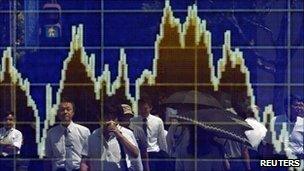Global currency trading jumps 20% in three years
- Published

Trading on the currency markets has grown by 20% in three years to $4 trillion a day
A three-year report into currency dealing shows rapid growth in trading, with the majority of business happening in London.
Trade has jumped by 20% in the three years since the last survey was conducted by the Bank for International Settlements (BIS), which is sometimes called the "central bankers' bank".
But London outpaced the average, with turnover up by 25% over the period.
Some $4 trillion (£2.6tn) changes hands around the world every day.
The BBC's business editor, Robert Peston, points out that the sum is equivalent to the entire output of the global economy being traded around once a fortnight on currency markets.
Simon Derrick, the head of currency research at Bank of New York Mellon, said the growth in foreign exchange trading reflects a number of important recent trends in the real economy - including the economic strength of developing countries.
He told the BBC: "If you look at the currencies where trading volumes have grown, they are typically commodity-backed - like the Australian dollar - or are the fast-growing emerging markets, such as China, Russia, Brazil and Turkey."
Misplaced fears
The single-largest centre of foreign exchange dealing remains London, with 37% of global turnover taking place in the city.
The survey's findings indicate that fears London may lose its place as a key financial centre are misplaced at present.
The US, the second most important currency centre, does about half the amount of trading that takes place in London.
Jeremy Stretch, market strategist at CIBC, said there were two reasons why London maintained its pre-eminent role.
"One is a geographical quirk - it straddles the time zones of the United States and Asia, and the other is because of heavy investment in infrastructure, such as IT systems."
The dollar remains the world's most-traded currency, accounting for 85% of all transactions, although that is down from the 90% it reached in 2001. The currency is still the world's central banks' favourite currency to hold in reserve.
Simon Derrick said central banks had been building up their reserve currency holdings and that was another reason for the rise in trading volumes.
Post-crisis snapshot
Growth in dealing has been driven by a combination of hedge funds, insurance firms, central banks and other non-bank financial institutions.
The BIS survey, in which 53 central banks and monetary authorities participated, presents the first snapshot of the currency markets since the 2008 financial crisis.
It includes a period that saw the end of the boom in the carry trade, where money is borrowed in currencies which have low interest rates and is used to invest in investments that bring higher rates of return.
The share of the low-yielding Japanese yen and the higher-yielding Australian dollar therefore rose as a percentage of all transactions.
Because two currencies are involved in each transaction, the sum of the percentage shares of individual currencies totals 200%, instead of 100%.
Euro/dollar remained by far the most dominant currency pair, with a 28% share.